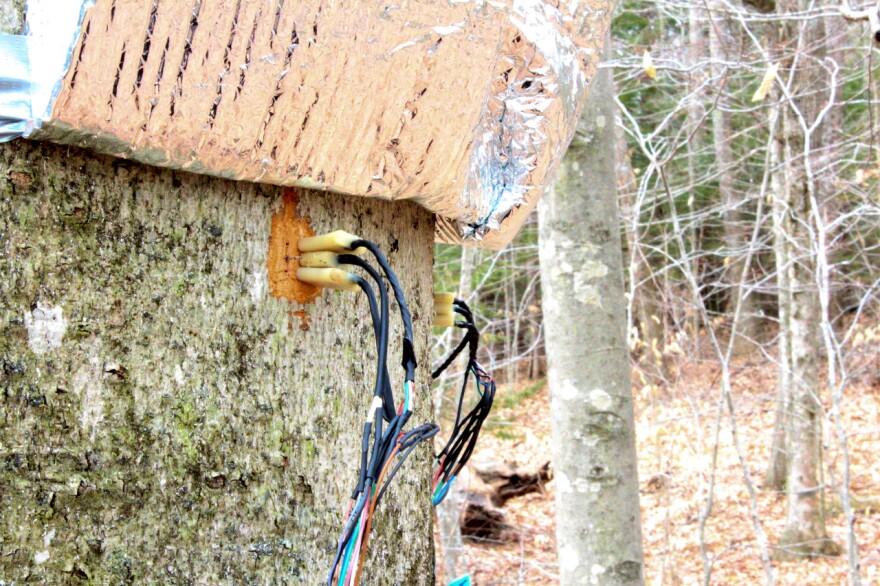Researchers at the University of New Hampshire are studying new ways to make syrup out of the northern forest -- not from maple trees, but from beeches, birches, sycamores and more. They want to create new markets for an industry that, right now, depends on just one kind of tree – making it vulnerable to disease and climate change.
This story is part of NHPR’s climate change reporting project, By Degrees. Click to see more.
At the tail end of maple sugaring season, other kinds of sap were still flowing freely in the woods of Lee. UNH researcher David Moore had sensors plugged into a stand of beech trees to measure that sap and the conditions helping produce it.

“You can see I have three trees with sensors here that are all tied back to one data logger," Moore said, pointing to the tubes and wires running from the beech trunks. Nearby, a bucket collected the resulting sap, while other equipment gathered weather data.
Researchers say monocultures, like the all-maple syrup industry, are more at risk from climate change, pests and other unpredictable threats.
So Moore sees untapped potential in other common species, like the American beech. It’s found throughout New Hampshire's forests, farms and sugar bushes – almost like a tree weed.
"If you can think of some economical use – if you can make syrup from them, that would be a nice way to actually generate a little profit from them,” Moore said.
Moore did that successfully for six years with his business, the Crooked Chimney, which sold syrups like birch and beech at farmers markets and to restaurants. It took a while for him fine-tune the process – these species don't like all the same temperatures and equipment as maples.
"The first year or two were a real learning curve for me,” Moore said. “But once I figured it out, I started tapping a lot more trees and selling syrup, and it turned out to be pretty good tasting syrup."
In the driveway of his house in Lee, he was steaming off some beech and sycamore syrup in big metal pots – the way maple syrup is boiled in a sugar shack. Part of Moore’s study at UNH aims to find the best processing techniques for these more finicky, less tested saps.
For a taste test, he produced two tiny glass bottles – one of birch syrup he made a few years ago, and one of beech syrup from New York-based New Leaf, run by Moore’s friend Mike Farrell.

“Let's start with the beech,” Moore said, pouring a caramel-colored spoonful. “I'm always interested to see what people think of it."
The beech syrup had a mild, sweet flavor – almost indistinguishable, at least to this reporter, from maple syrup.
The next spoonful, of Moore’s own New Hampshire birch syrup, was very different: dark and thick like molasses, with a tangy, savory flavor.
“I like to use it on meat – salmon and red meat,” Moore said. “You can mix it with balsamic vinegar and olive oil and make a nice salad dressing. Actually, my favorite use is probably ice cream."
This kind of syrup is usually sold in little bottles, at higher prices. But buyers see the value.
Get NHPR’s environment reporting delivered to your inbox - sign up for our newsletter today.
Evan Mallett is the chef-owner at Black Trumpet Bistro in Portsmouth. He likes tree syrup as a sweetener because it's less processed, more local and sustainable than cane sugar. He's used birch syrup in cocktails, in braises for venison and wild boar, and once, drizzled on an ostrich loin.
"Definitely, people respond by saying, ‘Oh, that's cool, I had no idea that you could harvest the sap of these other trees as well,’” Mallett said. “So it opens up that conversation, which can be a conservation conversation, an ecology conversation."
Mallett says using unexpected local ingredients like this helps connect people in a “magical” way to nature, their food system, and a very old and widespread tradition.
He mentions sorghum and watermelon syrups in the south, and boiled cider in the Adirondacks. Indigenous people and European colonizers traded techniques for getting sugar from trees. In Alaska and parts of Canada, where fewer maples grow, birch syrup is already well established.

"It's kind of remarkable that our sugar maple syrup industry has been so productive and sustainable overall, for such a long period of time, considering that it's essentially relied on just the one single species,” said UNH forestry professor Heidi Asbjornsen, who oversees David Moore's research.
She said supporting more diversity in syrups isn't just interesting, it's critical to the health of the changing forest. It's clear, she said, that spring is getting less predictable, which affects sap flow.
"We're going to see more variable years in terms of good versus bad sugaring seasons and sap yields,” Asbjornsen said.
Heat waves, droughts, ice storms – they could all affect maple trees. Vermont's syrup association had a short season with low sugar content this year, amid warm, dry conditions.
On the other hand, freeze-thaw cycles are a big part of what drives sap flow. Those are also on the rise, which could be good for sugaring.
New York-based syrup-maker Mike Farrell – producer of the beech syrup we tasted earlier – has a different fear: a specialized pest or disease, like emerald ash borer or chestnut blight.
"It's not the climate change becoming hotter and drier that's going to do it,” Farrell said. “It's if something like Asian longhorn beetle got out and wiped out all the maples – that would be devastating."
Researchers are trying to convince farmers that the more diverse their forests and products are, the more resilient they'll be. And they hope consumers will start to like the new flavors of these syrups, too.








